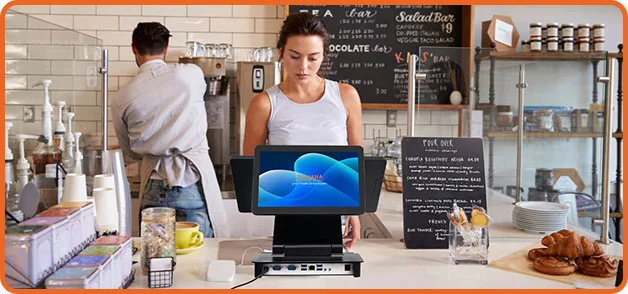

A Point of Sale (POS) system is a helpful tool that simplifies daily business tasks. It allows businesses to process sales quickly, track inventory in real-time, and manage customer payments seamlessly. This saves time and reduces the chances of human errors during transactions.Beyond sales, a POS system gives detailed reports on top-selling products, customer preferences, and sales trends. These insights help small business owners make smarter decisions, improve customer service, and grow their business efficiently. Investing in a POS system is a smart step toward running a smoother, more successful business.
A Point of Sale (POS) system is a combination of hardware and software that enables businesses to complete sales transactions. It includes a cash register, barcode scanner, receipt printer, and often a credit card reader. Modern POS systems also integrate software for managing inventory, sales reporting, customer data, and more.
A POS system is more than just a tool for processing sales. It acts as the central hub of a business’s operations, offering features that improve efficiency, reduce errors, and provide valuable insights.

For retail businesses, POS systems help with barcode scanning, managing promotions, and tracking stock across multiple locations.
In the food service industry, POS systems enable splitting bills, managing table reservations, and tracking ingredient inventory to minimize food waste.
POS systems designed for salons and spas allow businesses to schedule appointments, sell products seamlessly, and track customer preferences.
Setting up a POS terminal may seem challenging at first, but with the right guidance, it becomes straightforward. Follow these steps to get your POS terminal up and running:
Select a convenient and accessible spot for your POS terminal. Ensure it has sufficient space for the terminal, card reader, and receipt printer.
Unpack your POS terminal and connect all components, such as the monitor, cash drawer, receipt printer, and barcode scanner, following the manufacturer’s instructions.
Ensure your POS terminal is connected to a stable internet network. Use either Wi-Fi or an Ethernet cable, depending on your terminal’s compatibility.
Install the POS software on the terminal. Follow the prompts to complete the installation process, and ensure it is updated to the latest version.
Set up your business preferences, including tax settings, currency, and payment methods. Add product or service details to the system for accurate tracking.
Run a few test transactions to ensure the hardware and software are working correctly. Check if receipts print properly and payments process smoothly.
Provide training to your employees on how to use the POS system. Familiarize them with the system’s features and troubleshooting steps.
By following these steps, you can ensure a smooth setup process for your POS terminal, allowing you to focus on providing excellent service to your customers.
While a POS system is an investment, it can save money in the long run by reducing human errors, preventing theft, and optimizing inventory. For example, a retail store can avoid unsold stock by analyzing sales trends and purchasing the right amount.
When selecting a POS System, consider ease of use, scalability, industry-specific features, customer support, and integration capabilities. These factors ensure the system meets your business needs effectively.
Myth 1: “POS Systems Are Too Expensive.” Affordable options are available, and the efficiency gains often outweigh the initial investment.
Myth 2: “They’re Too Complicated to Use.” Modern systems are user-friendly, with intuitive interfaces requiring minimal training.
Myth 3: “Only Big Businesses Need a POS System.” Small businesses benefit greatly from the efficiency and insights provided by a POS system.
As technology evolves, POS systems are becoming more advanced with features like AI-driven analytics, mobile payments, and cloud-based systems. Early adoption of these technologies can help small businesses stay ahead of the curve.
A POS system is an invaluable tool for small businesses. It streamlines operations, improves customer satisfaction, and provides data-driven insights that drive growth. Whether you run a retail store, restaurant, or salon, investing in a POS system is a step toward greater efficiency and success. industrial touchscreen industrial panel pc stretched bar lcd